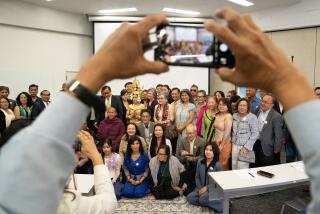Community Mourns Loss of Its Best Known
SANTA ANA — Members of Orange County’s Cambodian community on Monday mourned the loss of Dr. Haing Ngor, a man who many considered a role model who brought the Cambodian massacres of the mid- to late ‘70s to international attention.
Ngor, who was killed Sunday night outside his Los Angeles home, was viewed by many in the tight-knit community as someone who had survived the Khmer Rouge death camps and offered the world insight on the cruel years under Pol Pot regime through his 1984 Academy Award-winning performance in “The Killing Fields.”
“Among Cambodians, we only had one [person] that was well known and could get involved in international affairs,” said Keamty Lim as she gathered with her neighbors Monday afternoon on Minnie Street, where many Orange County Cambodians live.
“And now we have lost him.”
For many, Ngor put their homeland on the map.
“We were very proud of him,” said Nayky Ly, a resident of Laguna Niguel and a distant relative of Ngor’s. “To me, he was the person who represented the Cambodian people in the U.S. The whole world got to know Cambodia through him. Not too many people knew where Cambodia was--many thought it was inside Vietnam.”
At Cambodian Family Inc., a nonprofit educational center in Santa Ana, staff members fielded dozens of phone calls from Cambodians inquiring about Ngor’s death.
“Cambodians got to see themselves and their experience mirrored through him,” said Rifka Hirsch, the center’s executive director since 1983. “He was a spokesperson for what they went through.”
Ngor’s accomplishments made him somewhat of a folk hero among Cambodians living in the United States. On Minnie Street, many residents proudly hung movie posters in their homes when “The Killings Fields” was released. Others in the community told of harrowingly close calls with death as they fled their homeland, just as Ngor had suffered.
Some residents were fortunate to escape the concentration camps but lost many family members in the massacres. Ngor and many other Cambodians who survived the brutal camps did so only by lying about their professions and identities and finding ingenious ways to survive.
Among those targeted for death were religious leaders such as Soyudh Jenlar, now the head monk of a Buddhist temple in Santa Ana. In 1974, Jenlar said, he was led out to the jungles of Cambodia by Khmer Rouge soldiers, who tied him to a tree and seemed to be preparing to kill him. In a stroke of good fortune, he was able to untie himself when the soldiers were not looking and escaped into Thailand, enduring seven days without food.
Jenlar called Ngor’s death a terrible loss for the community.
“The Khmer Rouge was much harder than the movie [makes it seem], but the world got to see the situation in Cambodia because of that,” said Jenlar, who immigrated to the United States in 1985. “He was important to our people. He was a man who helped us.”
Somalie Sei, an educator at the Cambodian Family center, recalled meeting Ngor in 1986 when she lived in a refugee camp in Thailand and he was visiting with a group of international representatives.
“He talked about life in the U.S.,” said Sei, who previously spent four years in a Cambodian concentration camp. “He said that he got into the movie field and was proud of himself that he could act. He liked the life in the U.S., the freedom. He seemed very friendly to all the people and was very nationalistic.
“He cared about Cambodia. He was very sensitive and tried to help the country through the difficult times.”
Sei said she was saddened that Ngor had survived years of depravation and torment in Cambodia only to be killed on the streets of Los Angeles.
“People think that America is paradise because they escaped from the holocaust,” Sei said. “We were people with no human rights at all. We feel safe here, but its not like we are.”
More to Read
Sign up for Essential California
The most important California stories and recommendations in your inbox every morning.
You may occasionally receive promotional content from the Los Angeles Times.










